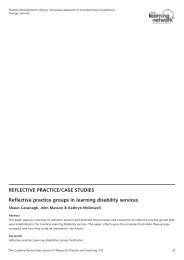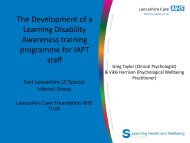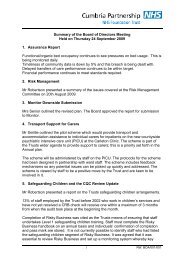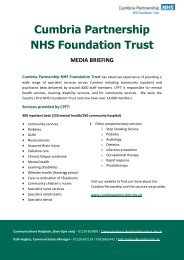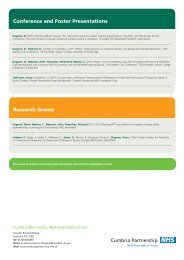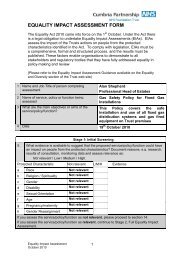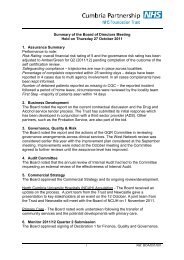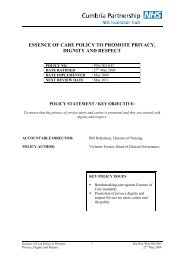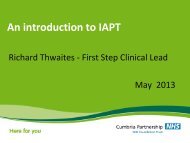RESEARCH REPORTS Measuring outcomes in learning disability ...
RESEARCH REPORTS Measuring outcomes in learning disability ...
RESEARCH REPORTS Measuring outcomes in learning disability ...
Create successful ePaper yourself
Turn your PDF publications into a flip-book with our unique Google optimized e-Paper software.
<strong>Measur<strong>in</strong>g</strong> <strong>outcomes</strong> <strong>in</strong> learn<strong>in</strong>g <strong>disability</strong> challeng<strong>in</strong>g behaviour servicesDiscussionThis study has described the use of force-field analysis toidentify barriers and drivers to the rout<strong>in</strong>e implementationof outcome measurement <strong>in</strong> learn<strong>in</strong>g <strong>disability</strong> challeng<strong>in</strong>gbehaviour teams. The analysis has shown that teams identifythe drivers and barriers that have the strongest effects, andthe biggest discrepancy between drivers and barriers, asbe<strong>in</strong>g at the level of the <strong>in</strong>dividual cl<strong>in</strong>ician and <strong>in</strong>dividualcl<strong>in</strong>ical practice. Thus it seems likely that the most effectivepo<strong>in</strong>ts to <strong>in</strong>tervene to change practice would be those at thelevel of the <strong>in</strong>dividual cl<strong>in</strong>ician.One of the most frequently cited barriers to change atthe <strong>in</strong>dividual level was a lack of knowledge and skillssurround<strong>in</strong>g the use of outcome measures. It is, therefore,suggested that regular tra<strong>in</strong><strong>in</strong>g <strong>in</strong> the use of particularmeasures would be highly beneficial. It may be helpful todraw upon the exist<strong>in</strong>g knowledge and experience with<strong>in</strong>staff teams. In this way, groups of cl<strong>in</strong>icians could be tra<strong>in</strong>edto use new measures on a regular basis, by members with<strong>in</strong>the team who are familiar with and/or rout<strong>in</strong>ely useparticular measures. It is proposed that such methods wouldenhance the knowledge and skills of the cl<strong>in</strong>icians, but alsothat observ<strong>in</strong>g examples of the use of measures by theircolleagues would build confidence and staff cohesion.Individual attitudes to change were identified as an<strong>in</strong>trapersonal barrier to improv<strong>in</strong>g rout<strong>in</strong>e outcomemeasurement. Thus, it may be useful for cl<strong>in</strong>icians to beprovided with a forum <strong>in</strong> which to voice their concerns andfears (such as at the shared practice day at which thisresearch was conducted) and to discuss difficulties <strong>in</strong> us<strong>in</strong>goutcome measures with colleagues and peers. Theidentification of a named cl<strong>in</strong>ician with some knowledge, aparticular <strong>in</strong>terest or significant experience <strong>in</strong> us<strong>in</strong>g outcomemeasures to which colleagues could br<strong>in</strong>g queries andconcerns may help to overcome some of the negativeattitudes towards this particular change <strong>in</strong> practice.Factors at other psychosocial levels that mightparticularly merit <strong>in</strong>tervention <strong>in</strong>clude further strengthen<strong>in</strong>gof the driver “need to demonstrate effectiveness andefficiency” and challeng<strong>in</strong>g a perceived “lack of resourcesand funds”. It is possible that these two issues (both ofwhich score highly <strong>in</strong> terms of their impact upon the currentequilibrium) could be l<strong>in</strong>ked <strong>in</strong> help<strong>in</strong>g the teams explorethe efficiencies possible as a result of good quality outcomeassessment that might demonstrate the “resource value” ofoutcome measurement systems.This paper has described the use of force-field analysis asa method to exam<strong>in</strong>e the challenges around the<strong>in</strong>troduction of effective outcome measurement. The paperhas provided important <strong>in</strong>sights <strong>in</strong>to cl<strong>in</strong>ical understand<strong>in</strong>gof this issue. It is suggested that the method is a useful tool<strong>in</strong> develop<strong>in</strong>g understand<strong>in</strong>g of organisational issues and <strong>in</strong>produc<strong>in</strong>g implementation plans based upon the experienceof participants.AffiliationsJane Birrell, Cl<strong>in</strong>ical Psychologist, Cumbria Partnership NHSFoundation TrustProfessor Dave Dagnan, Consultant Cl<strong>in</strong>ical Psychologist &Cl<strong>in</strong>ical Director, The Learn<strong>in</strong>g Network, Cumbria PartnershipNHS Foundation TrustContact <strong>in</strong>formationProfessor Dave Dagnan, dave.dagnan@cumbria.nhs.uk.Key ReferencesBritish Psychological Society (2004). Psychological<strong>in</strong>terventions for severely challeng<strong>in</strong>g behaviours shown bypeople with learn<strong>in</strong>g disabilities: Cl<strong>in</strong>ical Practice Guidel<strong>in</strong>es.Leicester: BPSDagnan, D. (2007). Psychosocial <strong>in</strong>terventions for peoplewith learn<strong>in</strong>g disabilities. Advances <strong>in</strong> Mental Health andLearn<strong>in</strong>g Disabilities, 2, 3-7.Darzi, A. (2008). High quality care for all: NHS next stagereview f<strong>in</strong>al report. London: Department of Health.Hatfield, D. R., & Ogles, B. M. (2004). The use of outcomemeasures by psychologists <strong>in</strong> cl<strong>in</strong>ical practice. ProfessionalPsychology, 35, 485-491.Lew<strong>in</strong>, K. (1951). Field theory <strong>in</strong> social science. New York:Harper & Row.Mould<strong>in</strong>g, N. T., Silagy, C. A., & Weller, D. P. (1999). Aframework for effective management of change <strong>in</strong> cl<strong>in</strong>icalpractice: Dissem<strong>in</strong>ation and implementation of cl<strong>in</strong>icalpractice guidel<strong>in</strong>es. Quality <strong>in</strong> Health Care, 8, 177-183.West, M. A., & Farr, J. L. (1989). Innovation at work:Psychological perspectives. Social Behaviour, 4, 15-30.8 The Cumbria Partnership Journal of Research, Practice and Learn<strong>in</strong>g 1(1)



